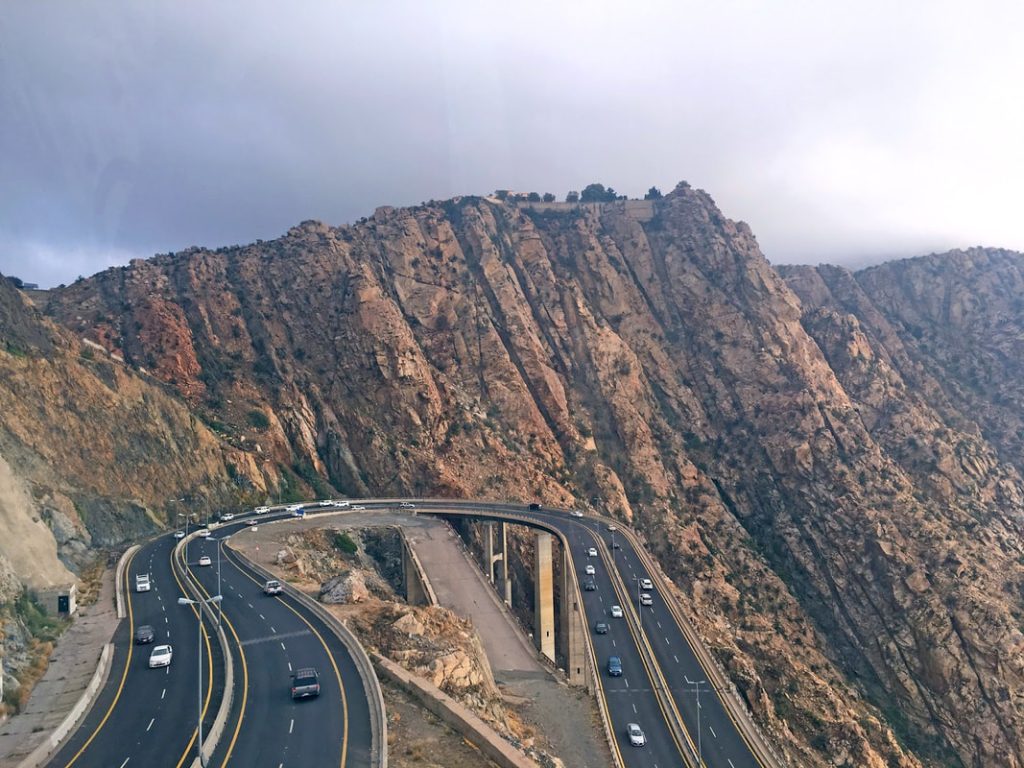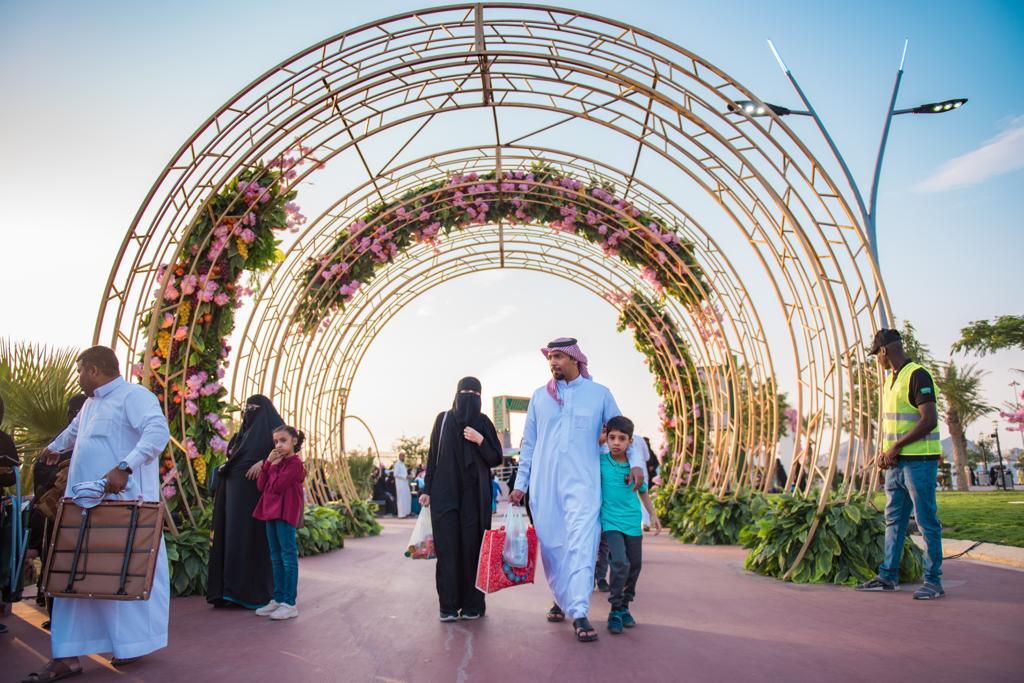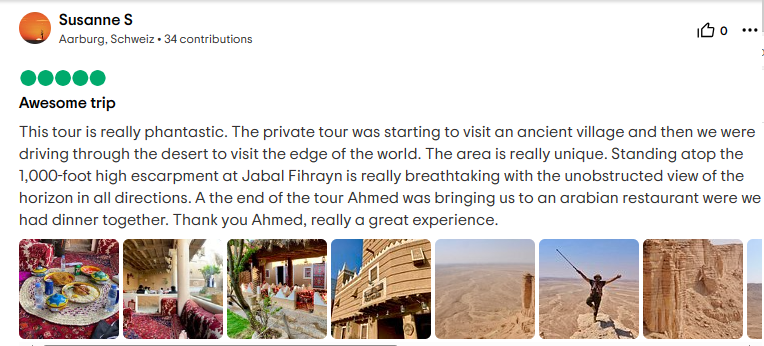
Nestled amidst the rugged beauty of the Sarawat Mountains, Taif City stands as a jewel in the crown of Saudi Arabia. Known for its enchanting landscapes, moderate climate, and rich cultural heritage, Taif is a city that captivates the hearts of those who wander into its embrace.
Perched at an elevation of over 1,800 meters above sea level, Taif enjoys a temperate climate, making it a popular retreat for both locals and visitors seeking respite from the scorching temperatures that characterize much of the region. The city is renowned for its lush orchards, fragrant rose gardens, and verdant valleys, creating a picturesque setting that paints a canvas of tranquility.
Beyond its natural allure, Taif carries a storied history that dates back centuries. The city has been a crossroads for various civilizations, leaving behind a tapestry of influences that can be witnessed in its architecture, traditions, and local customs. From the historic Shubra Palace to the vibrant Souq Okaz, Taif offers a journey through time, allowing visitors to immerse themselves in the rich cultural heritage that defines the city.
One of Taif’s signature experiences is the annual Taif Rose Festival, where the air becomes infused with the delicate scent of blooming roses. The festival not only celebrates the city’s floral abundance but also highlights its commitment to sustainable agriculture and traditional craftsmanship.
As you navigate the winding streets of Taif, you’ll encounter warm hospitality and a genuine embrace of tradition. The city’s locals take pride in preserving their cultural identity, creating an inviting atmosphere for those eager to explore the nuances of Arabian heritage.
Join us on a virtual journey through the streets of Taif City, where the convergence of nature, history, and culture creates an experience that lingers in the heart long after the journey ends.
Location of Taif
Taif City is strategically situated in the western part of Saudi Arabia, perched on the eastern slopes of the Sarawat Mountains, which form part of the larger Hijaz Mountain range. Geographically, it is positioned at an elevation of approximately 1,879 meters (6,165 feet) above sea level. This elevated location contributes to Taif’s unique climate, offering a refreshing escape from the intense heat that characterizes much of the Arabian Peninsula.
The city is approximately 70 kilometers (43 miles) east of the Red Sea and lies about 1,300 kilometers (810 miles) southwest of the Saudi capital, Riyadh. Its proximity to the coast and elevated position contribute to the moderate temperatures and cool breezes that make Taif a favored destination, especially during the scorching summer months when temperatures in other parts of the country soar.
The mountainous terrain surrounding Taif not only provides a stunning backdrop but also adds to the city’s charm. The landscape is dotted with orchards, gardens, and valleys, creating a lush and picturesque environment. The city’s location has historically made it a vital crossroads for trade and cultural exchange, influencing its diverse heritage and architectural character.
For those embarking on a journey to Taif, the drive from the coastal city of Jeddah is an adventure in itself. The road winds through the majestic mountainous landscapes, offering breathtaking vistas along the way. Whether arriving by road or air, the journey to Taif unveils the natural beauty that sets the stage for a memorable experience in this enchanting Saudi Arabian city.
The History of Taif
Taif’s history is a tapestry woven with threads of ancient civilizations, cultural crossroads, and significant events that have shaped its identity throughout the centuries. As one of the oldest cities in Saudi Arabia, Taif’s historical narrative is a testament to its resilience, adaptability, and enduring charm.
The earliest traces of human habitation in the Taif region date back to prehistoric times, with archaeological evidence suggesting that the area has been inhabited for thousands of years. The city’s strategic location on trade routes connecting the Arabian Peninsula to the Levant and beyond made it a hub for commerce and cultural exchange.
In the 6th century, Taif gained historical significance as the site of the Battle of Ta’if during the early years of Islam. Despite initial resistance, the city eventually embraced the Islamic faith, becoming an integral part of the expanding Islamic civilization.
Throughout the centuries, Taif continued to thrive as a center for agriculture, trade, and pilgrimage. It served as a vital stop on the pilgrimage route to Mecca, welcoming travelers and traders from diverse backgrounds. The city’s economic prosperity was fueled by its fertile soil, which supported the cultivation of various crops, including the famed Taif roses.
During the Ottoman Empire, Taif became an administrative center, further solidifying its importance in the region. The Ottomans left their architectural imprint on the city, with remnants of their influence still visible in some historical structures.
In the 20th century, Taif underwent significant modernization and development, while carefully preserving its historical and cultural heritage. Today, visitors can explore landmarks such as Shubra Palace, a historic residence that provides a glimpse into the lifestyle of the city’s past rulers. Additionally, the Souq Okaz, an ancient marketplace, speaks to Taif’s role as a cultural and commercial hub.
Taif’s annual Rose Festival, celebrating the city’s renowned rose gardens, exemplifies its commitment to preserving traditional practices while embracing the future. The city’s rich history, evident in its architecture, traditions, and cultural events, invites visitors to embark on a journey through time, immersing themselves in the layers of the past that continue to shape Taif’s vibrant present.
Taif’s Significance

Taif, with its rich history, breathtaking landscapes, and cultural tapestry, holds a profound significance that extends far beyond its geographical boundaries. This Saudi Arabian gem is not merely a city but a symbol of resilience, diversity, and a bridge between the past and the present. In our exploration of Taif’s significance, we uncover the layers that make this city a destination of unparalleled allure.
1. Spiritual Sanctuary:
Taif has long been revered as a spiritual haven. Historically, it played a pivotal role as a stop on the pilgrimage route to Mecca, welcoming pilgrims with its cool climate and serene landscapes. The city’s embrace of Islam during the early years marked a significant chapter in its history, solidifying its place in the annals of the faith.
2. Cultural Crossroads:
Situated at the crossroads of ancient trade routes, Taif emerged as a melting pot of cultures and influences. The city’s diverse heritage is reflected in its architecture, traditions, and the warm hospitality of its people. From the Ottoman-era structures to the vibrant Souq Okaz, Taif stands as a living testament to the interweaving threads of history and culture.
3. Agricultural Abundance:
The fertile soil of Taif has been a source of sustenance and economic prosperity for centuries. Orchards laden with fruit, including the renowned Taif roses, paint the landscape in vibrant hues. The city’s agricultural significance is not only a testament to its prosperity but also a reflection of the harmonious coexistence between nature and human endeavor.
4. Therapeutic Retreat:
Perched at an elevation of over 1,800 meters, Taif offers a respite from the heat of the surrounding plains. The cool mountain air and the picturesque surroundings have turned Taif into a favored retreat for those seeking a therapeutic escape. Whether it’s the healing properties of the local rose water or the serene ambiance of the mountains, Taif provides a sanctuary for rejuvenation.
5. Blossoming Traditions:
The annual Taif Rose Festival is a celebration of the city’s fragrant blooms and a homage to the traditions of sustainable agriculture. This event not only showcases the natural beauty of Taif but also underscores its commitment to preserving and promoting cultural practices that have defined the region for generations.
In essence, Taif is more than a city; it’s a living story etched into the fabric of Arabia. Its significance lies not only in its historical landmarks but in the spirit of its people, the embrace of diverse influences, and the commitment to preserving the natural and cultural treasures that make Taif an enduring destination of importance and charm. Join us on a journey through Taif, where every step is a connection to the heart of Saudi Arabia’s past and present.
Climate of Taif
The climate of Taif is a refreshing departure from the typical desert heat associated with Saudi Arabia, offering a haven of coolness and tranquility due to its elevated location in the Sarawat Mountains. The city’s climate is characterized by its moderate temperatures, making it a sought-after retreat, especially during the scorching summer months.
1. Moderate Summers:
Taif experiences relatively mild summers compared to other regions in Saudi Arabia. While temperatures can reach warm levels, the elevation of the city, which exceeds 1,800 meters (5,900 feet) above sea level, ensures that the heat is more bearable. Summer temperatures typically range from 20 to 30 degrees Celsius (68 to 86 degrees Fahrenheit), providing a welcome escape for those seeking cooler climes.
2. Refreshing Breezes:
One of the defining features of Taif’s climate is the cool mountain breeze that sweeps through the city. The gentle winds contribute to the overall pleasant atmosphere, creating an environment that contrasts starkly with the arid plains found in other parts of the country.
3. Mild Winters:
Winters in Taif are characterized by mild temperatures, and while it can get cooler during the evenings, snowfall is a rare occurrence. Daytime temperatures generally range from 10 to 20 degrees Celsius (50 to 68 degrees Fahrenheit), offering a comfortable and temperate climate that is inviting for outdoor activities.
4. Ideal Growing Conditions:
The climate of Taif, particularly its cool nights and moderate temperatures, has contributed to the city’s agricultural significance. The fertile soil, coupled with the suitable climate, supports the cultivation of a variety of crops, including apples, pomegranates, and the famous Taif roses.
5. Year-Round Appeal:
Taif’s climate makes it an attractive destination throughout the year. Whether visitors are seeking relief from the summer heat or a serene winter retreat, Taif’s weather provides a versatile backdrop for a range of experiences, from exploring the city’s cultural heritage to wandering through its lush gardens.
In essence, Taif’s climate is a key element of its charm, offering a refreshing and invigorating atmosphere that sets it apart from other cities in Saudi Arabia. Whether you’re strolling through the rose gardens or exploring historical sites, the climate of Taif adds an extra layer of allure to this enchanting city in the mountains.
Site and People of Taif
Nestled within the embrace of the Sarawat Mountains, Taif is a city where nature and culture harmoniously converge, creating a captivating tapestry of sites and people that tell the story of this enchanting Saudi Arabian destination.
1. Architectural Splendors:
The cityscape of Taif is adorned with architectural treasures that span different eras and civilizations. Shubra Palace, a historic residence, stands as a testament to the city’s royal heritage. Its ornate design and intricate details provide a glimpse into the opulent lifestyle of Taif’s past rulers. Additionally, remnants of Ottoman influence are evident in structures like the Al-Hada Ottoman Mosque, showcasing the city’s role as a cultural crossroads.
2. Souq Okaz:
A bustling marketplace since ancient times, Souq Okaz embodies the vibrant spirit of Taif. This historical market was once a hub for traders, poets, and intellectuals from across the Arabian Peninsula. Today, the souq remains a vibrant center where traditional crafts, spices, and local wares create a sensory delight for visitors. The lively atmosphere reflects the enduring vitality of Taif’s commercial and cultural heritage.
3. Natural Retreats:
Taif’s people are deeply connected to the city’s natural wonders. The city is surrounded by lush orchards, verdant valleys, and the famed rose gardens. Locals and visitors alike find solace in the cool mountain air, engaging in activities like hiking, picnicking, and enjoying the scenic beauty of places like Wadi Mitna. Taif’s natural retreats not only offer a respite from the heat but also serve as communal spaces where people come together to appreciate the beauty of their surroundings.
4. Warm Hospitality:
The people of Taif are renowned for their warm hospitality and welcoming demeanor. Whether wandering through the historic streets or exploring the bustling markets, visitors are greeted with genuine kindness. The locals take pride in sharing their cultural heritage, offering insights into traditional practices, and creating an atmosphere that fosters a sense of community.
5. Taif Rose Festival:
An annual celebration that encapsulates the essence of Taif, the Rose Festival is a testament to the city’s agricultural prowess and cultural significance. The event showcases the delicate beauty and fragrance of Taif roses, symbolizing the enduring connection between the people and the land. It is a time when the community comes together to honor their traditions and share the bounty of their harvest.
In the heart of Taif, the sites and people seamlessly intertwine, creating an immersive experience for those who venture into this mountainous haven. From the echoes of ancient marketplaces to the contemporary vibrancy of the city, Taif beckons travelers to become part of its living history, where every step unveils a new layer of cultural richness and natural splendor.
Best Attractions in Taif

Taif, with its blend of historical significance, natural beauty, and cultural richness, is a treasure trove of attractions that beckon travelers to explore its enchanting landscapes. From historic palaces to verdant gardens, here are some of the best attractions that make Taif an unforgettable destination:
1. Shubra Palace:
Step into the regal past of Taif with a visit to Shubra Palace. This historic residence, nestled within lush gardens, offers a glimpse into the lifestyle of Taif’s royalty. The palace’s architecture and ornate details transport visitors to a bygone era, providing a cultural and historical immersion.
2. Souq Okaz:
The heartbeat of Taif’s cultural and commercial scene, Souq Okaz is a vibrant marketplace that has been a hub of activity for centuries. Stroll through its bustling lanes, where traders once gathered for commerce and poets recited verses. Today, the souq continues to enchant with its traditional crafts, spices, and a lively atmosphere.
3. Taif Rose Gardens:
Immerse yourself in the fragrant allure of Taif at the city’s renowned rose gardens. These lush expanses burst into vibrant hues during the annual Taif Rose Festival. The intoxicating scent of blooming roses creates an atmosphere of tranquility, making a visit to the rose gardens a sensory delight.
4. Al-Hada Mountain:
For panoramic views of Taif and its surroundings, venture to Al-Hada Mountain. A scenic drive along its winding roads reveals breathtaking landscapes and overlooks. The cool mountain air and the picturesque setting make Al-Hada Mountain a perfect escape, offering a refreshing contrast to the desert plains.
5. Wadi Mitna:
Nature enthusiasts will find bliss in the embrace of Wadi Mitna. This picturesque valley, framed by rugged mountains, is a haven for hiking and picnicking. The clear streams, verdant flora, and the soothing sounds of nature make Wadi Mitna a peaceful retreat for those seeking outdoor adventures.
6. Al Shafa:
Al Shafa is a charming village situated on the slopes of the Sarawat Mountains, renowned for its cool climate and beautiful scenery. The village is dotted with historic homes and offers stunning views of the surrounding landscapes. It’s an ideal destination for a leisurely day trip or a peaceful retreat.
7. Rock Carvings at Jabel Ikma:
Delve into Taif’s prehistoric past by exploring the rock carvings at Jabel Ikma. These ancient petroglyphs provide a fascinating glimpse into the lives of early inhabitants, showcasing their artistry and cultural practices. The site is a testament to Taif’s role as a cradle of civilization.
From the regal echoes of Shubra Palace to the natural wonders of Wadi Mitna, Taif unfolds its treasures to those eager to explore. Each attraction contributes to the city’s multifaceted allure, inviting visitors to unravel the layers of history, culture, and natural beauty that define this jewel in the Sarawat Mountains.
Best Things to Do In Taif
Taif, with its cool mountain air, historic charm, and natural wonders, offers a plethora of experiences for every traveler seeking a blend of culture, relaxation, and outdoor exploration. Here are the best things to do in Taif that promise to make your visit truly memorable:
1. Explore Shubra Palace:
Step back in time with a visit to Shubra Palace. Wander through its elegant halls, adorned with traditional Saudi Arabian architecture and exquisite details. The palace provides a fascinating glimpse into the lifestyle of Taif’s royalty, offering a cultural journey through the city’s rich history.
2. Roam Through Souq Okaz:
Dive into the heart of Taif’s vibrant culture at Souq Okaz. This historic marketplace, once a meeting point for traders, poets, and intellectuals, still buzzes with life. Immerse yourself in the lively atmosphere, where you can shop for traditional crafts, spices, and local wares while soaking in the authentic Arabian ambiance.
3. Experience the Taif Rose Festival:
Timing your visit with the annual Taif Rose Festival is a sensory treat. Held during the blooming season, the festival celebrates the city’s famous roses. Engage in the festivities, from exploring rose gardens to witnessing the production of rose water, and immerse yourself in the fragrant charm that defines Taif.
4. Take a Scenic Drive to Al-Hada Mountain:
Embark on a scenic drive to Al-Hada Mountain, where winding roads reveal breathtaking vistas of Taif and its surroundings. The cool mountain air and panoramic views make this journey a rejuvenating experience. Stop at viewpoints along the way to capture the beauty of the Sarawat Mountains.
5. Hike in Wadi Mitna:
Nature enthusiasts will find bliss in the serene landscapes of Wadi Mitna. Lace up your hiking boots and explore the winding trails surrounded by rugged mountains. The clear streams and lush greenery provide a peaceful setting for a day of outdoor adventure or a leisurely picnic.
6. Discover Al Shafa Village:
Escape to the charming village of Al Shafa, perched on the slopes of the Sarawat Mountains. This tranquil retreat offers cool temperatures and stunning views. Stroll through the village, admire historic homes, and savor the peaceful ambiance that makes Al Shafa a perfect destination for relaxation.
7. Uncover Ancient Petroglyphs at Jabel Ikma:
Delve into Taif’s prehistoric past by visiting Jabel Ikma. The rock carvings, or petroglyphs, provide a fascinating insight into the lives of early inhabitants. Take a guided tour to understand the significance of these ancient artworks, which tell tales of the region’s rich cultural heritage.
8. Enjoy Outdoor Activities at Al Rudaf Park:
For a family-friendly outing, head to Al Rudaf Park. This well-maintained green space offers playgrounds, walking paths, and recreational areas. Enjoy a leisurely stroll, have a picnic, or engage in outdoor activities, making it an ideal spot for relaxation and entertainment.
Taif’s diverse offerings ensure that every visitor finds something to suit their preferences. Whether you’re drawn to cultural exploration, outdoor adventures, or simply unwinding in nature, Taif invites you to savor the richness of its experiences and create lasting memories in this mountainous oasis.

How Good are Saudi Arabia Tours?
Saudi Arabia Tours prides itself on being the best travel agency in Saudi Arabia as proven by our numerous positive reviews.



Frequently Asked Questions?
Is Saudi Arabia safe for tourists?
Tourists have been visiting Saudi Arabia and Saudi Arabians have a well-earned reputation for warmth and kindness toward visitors. Saudi Arabia cities are generally very safe, especially in areas where tourists frequent.
How to get a Saudi tourist visa?
Applying for a tourist visa to Saudi Arabia is easy. If you are from one of the 49 eligible countries, you can apply through the eVisa website. Holders of US, UK, or Schengen visas can apply for the visa upon arrival. Saudi Arabia is opening its doors to the world through its new tourist visa. Visitors will have the chance to discover and experience the warm hospitality of the Saudi people, the rich heritage, the vibrant culture, and Saudi Arabia’s diverse and breathtaking landscapes. The visa will be a one-year, multiple-entry visa, allowing tourists to spend up to 90 days in the country.
Are non-Muslims allowed in Saudi?
Non-Muslims can travel to all cities in Saudi Arabia except Medinah and Mekkah, Not allowed to non-Muslims to enter Mecca and Medinah.
Can I wear jeans in Saudi Arabia?
Both men and women are asked to dress modestly in public, avoiding tight-fitting clothing. Women should cover their shoulders and knees in public.
Contact us for more information on:
saudiarabiatours.net@gmail.com
Address: Head Office Olaya St, Riyadh 12213, Saudi Arabia.
If you are booking and taking the tour within 24 hours, or have an urgent request, call us on
Cell/whatsapp : +966558018938 For more info please visit Saudi Arabia Tours

